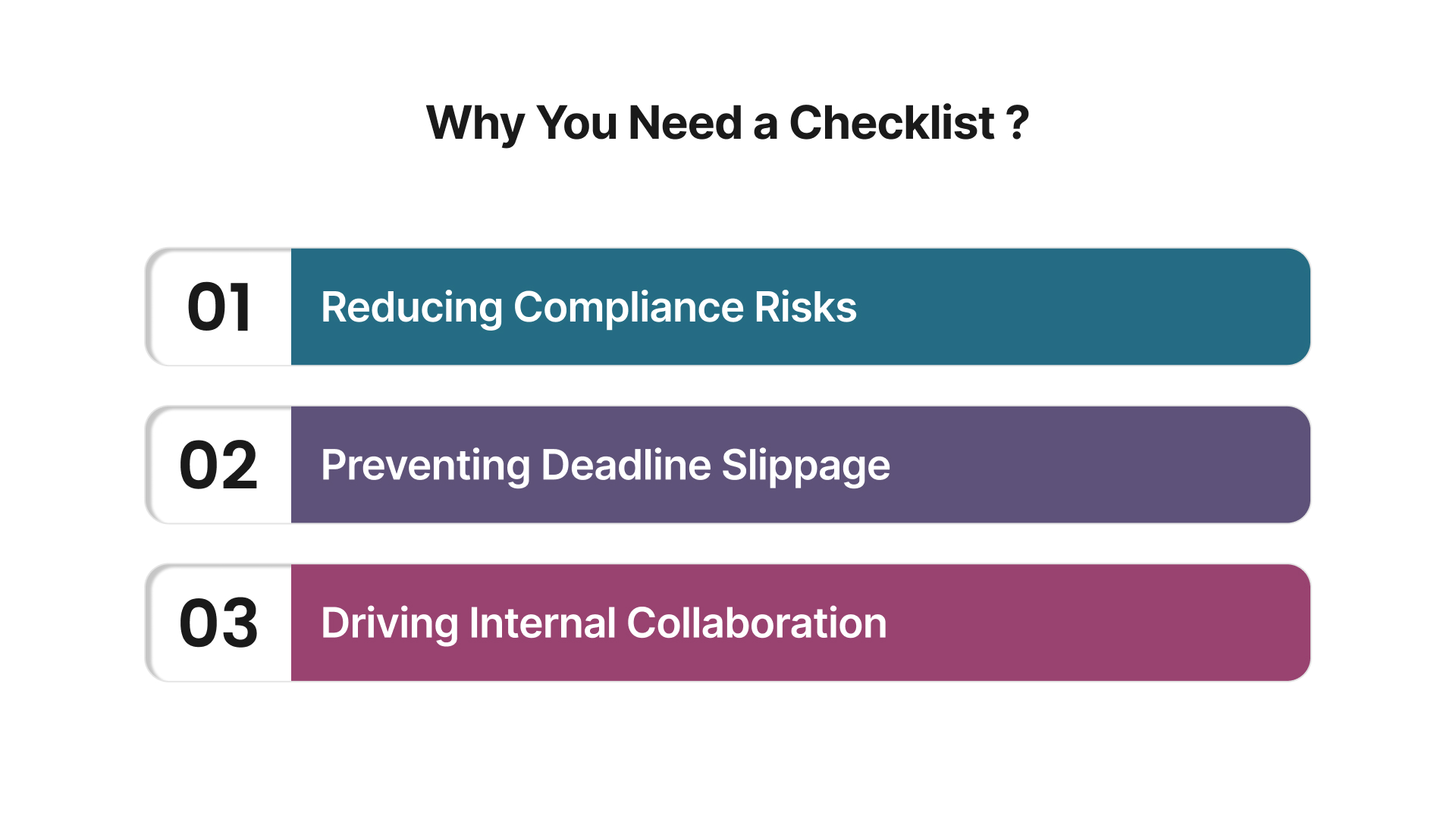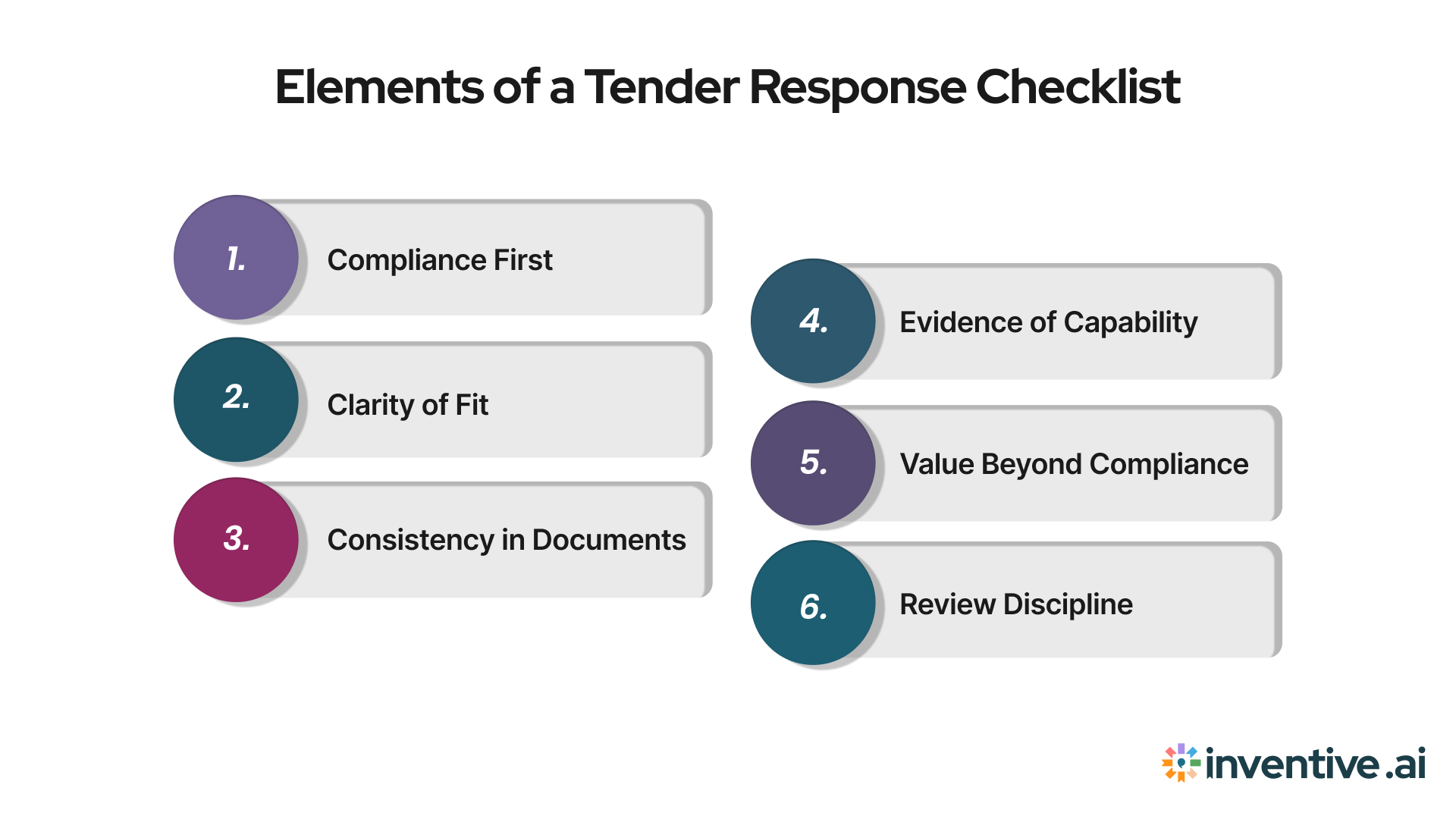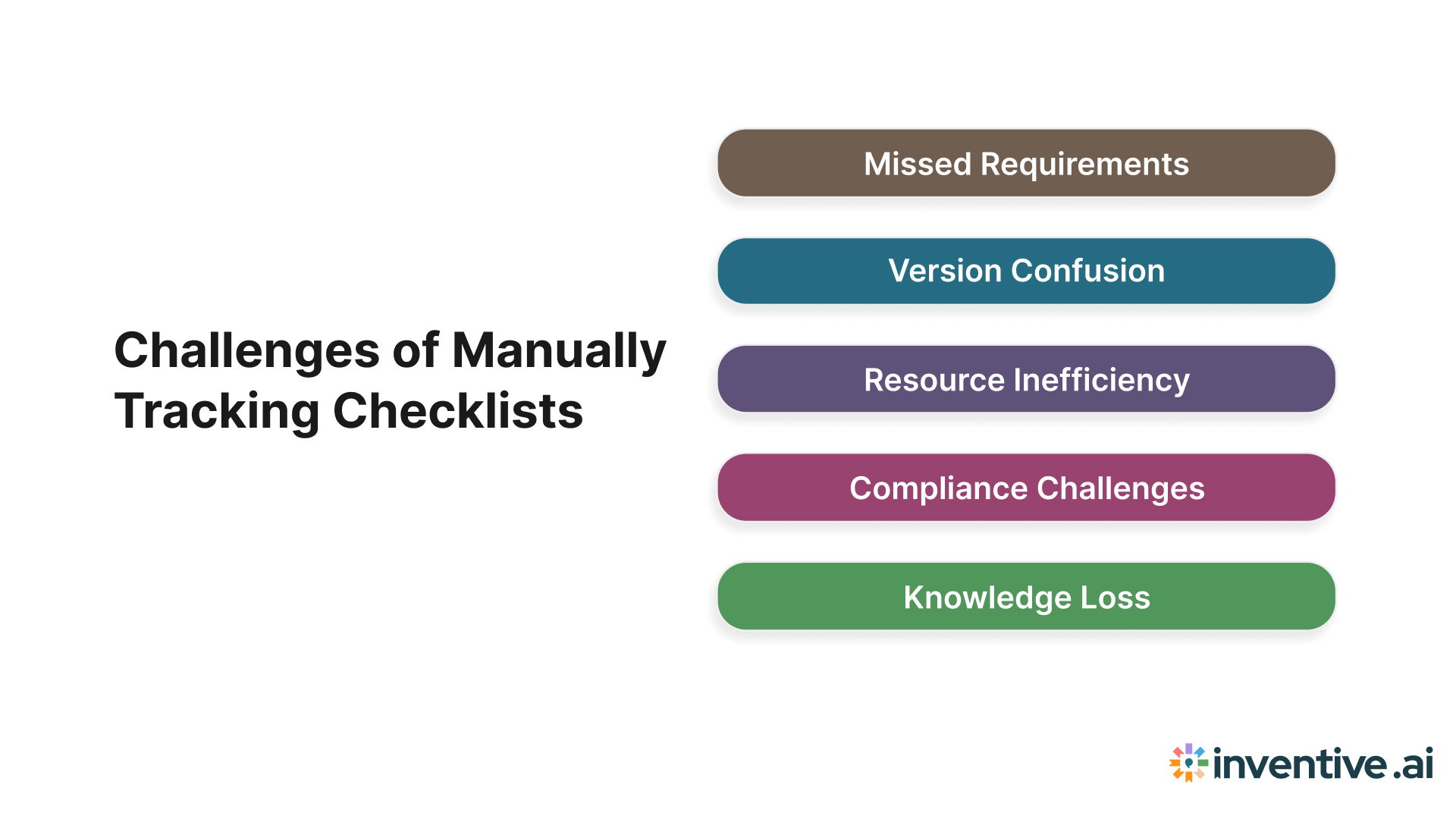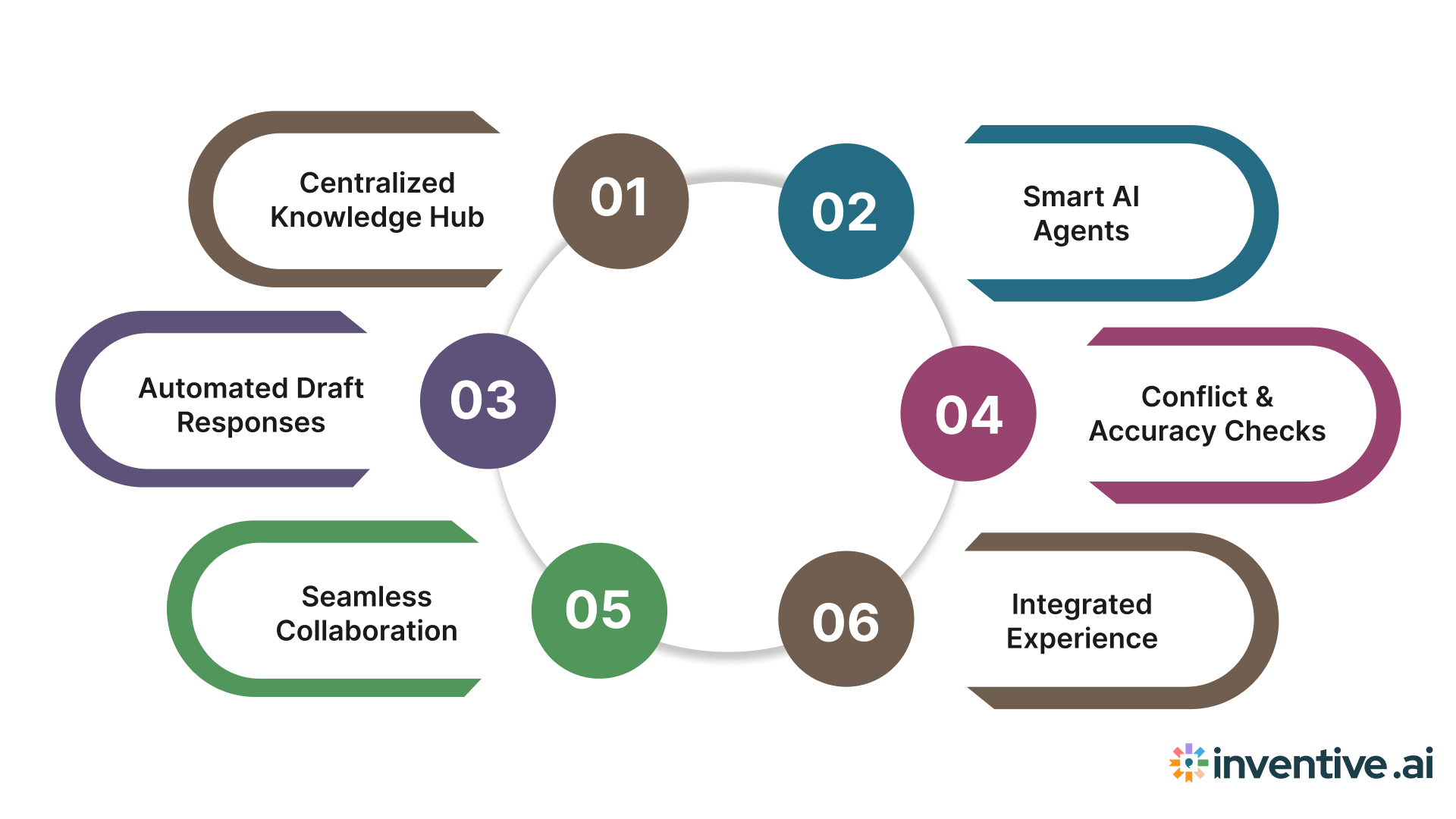Checklist for Tender Response Management (+ Template)
Explore a comprehensive checklist for tender response management in this guide, with a downloadable template to streamline your process.

Managing tender responses is high-stakes work, yet many teams rely on static, one-size-fits-all checklists that create more stress than structure. Poorly managed lists can lead to miscommunication, duplicated effort, and missed requirements, slowing down your bids and increasing the risk of errors.
In this blog, we walk you through a structured tender response management checklist and provide a downloadable, editable template. You’ll learn how to organize, track, and optimize your checklist to save time, reduce errors, and keep your team aligned throughout every bid.
TL;DR
- Each stage of the tender response process, from opportunity assessment to post-submission follow-up, can be tracked systematically using a checklist.
- Manual management of these stages creates bottlenecks, miscommunication, and errors.
- AI can automate tracking, validate responses, and surface relevant content from libraries instantly
- Implementing structured checklists with AI support transforms tender response into a faster, more reliable, and measurable process.
What Is Tender Response Management?
Tender response management is the structured process vendors follow to prepare, organize, and deliver a complete response to a buyer’s tender or RFP.
Unlike general proposals, tender responses leave no room for flexibility. They follow strict buyer-defined structures, are evaluated against fixed scoring criteria, and demand complete compliance where a single missing certificate can disqualify even the strongest bid. Timelines are rigid, and the focus is on aligning precisely with requirements rather than selling broadly.
Because the process is high-stakes and unforgiving, response teams need a checklist to ensure no requirement slips through the cracks. A well-designed checklist acts as a safeguard, turning a complex and error-prone process into a predictable and repeatable one.
Why You Need a Checklist for Tender Response Management

A tender response has zero margin for error. Buyers disqualify incomplete or inconsistent bids in seconds, regardless of how strong the offering may be.
If your team is manually entering each requirement without a clear structure, they could be wasting hours every day. Research shows that 76% of office workers spend up to three hours per day on manual data entry. Using a structured checklist centralizes all tasks, ensures nothing is missed, and significantly reduces wasted effort."
A checklist is not just a project management tool; it is a control system that keeps teams compliant, coordinated, and competitive.
1. Reducing Compliance Risks
Most tender disqualifications happen before evaluators even review the content. Missing a single certificate, form, or declaration can remove you from consideration. A checklist keeps every mandatory requirement visible and trackable.
Example: If the buyer requests five years of audited financials and one year is missing, the bid is often rejected without scoring.
2. Preventing Deadline Slippage
Tenders come with immovable submission dates. Any delay in drafting, approvals, or uploads can mean a lost deal. A checklist creates visibility across dependencies and deadlines.
3. Driving Internal Collaboration
Tender responses are rarely written by one person. Legal, finance, technical, and sales all contribute. Without a checklist, work often overlaps or gets missed.
Checklist Impact:
- Defines ownership for each section
- Keeps team members aligned on document versions
- Reduces duplicate requests for the same input
A checklist is only as effective as its design. Knowing what to include and what most teams overlook separates winning responses from wasted effort. The next section breaks down the essential elements of a tender response checklist, enabling your team to ensure compliance and improve scores.
Essential Elements of a Tender Response Checklist

A strong checklist is not just a list of attachments. It’s a way of thinking through the tender from the evaluator’s point of view. Buyers don’t scan for extras first—they filter, score, and differentiate using specific lenses. Building your checklist around these perspectives ensures every response aligns with how decisions are actually made.
- Compliance First: Buyers start by eliminating any submission that misses mandatory requirements. A checklist must flag every non-negotiable item, because compliance is the gatekeeper before scores are even considered.
- Clarity of Fit: Evaluators want to see exactly how your solution maps to their stated requirements. The checklist should confirm that each demand is acknowledged and answered in terms that the buyer can measure against their criteria.
- Consistency Across Documents: Scorers lose confidence if numbers, messaging, or commitments differ across sections. A checklist perspective ensures alignment in tone, pricing, and positioning, so the response feels like one cohesive voice.
- Evidence of Capability: Buyers rarely take claims at face value. They look for proof: case studies, references, certifications, or metrics that validate delivery. The checklist should pressure-test whether each claim has supporting evidence.
- Value Beyond Compliance: Once the basics are covered, evaluators search for differentiation. A checklist should confirm that your response doesn’t just tick boxes but also highlights advantages, efficiency, or innovation that matter to the buyer.
- Review Discipline: The checklist perspective ensures governance steps are built in so nothing undermines credibility at the last mile.
A checklist only works if it is mapped to the reality of how tender responses are built. That means aligning it to the sequence of stages every vendor must go through. By following the process step by step, you reduce risk, maintain consistency, and improve evaluation scores. The first stage begins well before the buyer issues the tender: Pre-Tender Preparation.
1. Pre-Tender Preparation
Success in tender response starts long before the first page is drafted. Expert teams approach this phase with a structured methodology, ensuring every decision, document, and deadline is aligned to maximize the probability of winning and minimize wasted effort.
Eligibility and Go/No-Go Decision
Experienced vendors apply a disciplined decision framework to determine whether a tender is worth pursuing. This process combines strategic, financial, and operational criteria:
- Strategic Fit: Does the opportunity align with your core offerings and growth goals?
- Profitability Assessment: Are margins sufficient to justify investment in preparation and delivery?
- Capacity Check: Can your team realistically meet the requirements within the timeline without overextending resources?
Organizations often use scoring models, assigning weighted points to each criterion. Internal governance ensures that decisions are reviewed by leadership to prevent pursuing low-probability bids, which can drain time and resources from higher-value opportunities.
Pro Tip: Maintain a historical database of past tenders with win/loss outcomes to refine scoring over time.
Also Read: Go/No-Go Decision Process: Steps & Checklist for Projects
Gather Documents
A critical component of preparation is assembling all mandatory compliance and credential documentation, which often includes:
- ISO certifications
- SOC 2 or equivalent audit reports
- HIPAA compliance evidence
- Insurance certificates
- Company policies and internal procedures
Maintaining these documents in a centralized, version-controlled repository reduces errors, prevents outdated content from being reused, and allows teams to retrieve credentials quickly when deadlines are tight.
Build Your Tender Response Team
Establish a cross-functional team that may include:
- Sales representatives for client context and commercial strategy
- Legal for contractual and compliance review
- Subject-matter experts to provide technical accuracy
- Finance for cost and margin validation
Clear role assignments and defined review cycles keep contributions coordinated and reduce bottlenecks. Proposal managers orchestrate the process, ensuring accountability and timely input from every stakeholder.
Pro Tip: Conduct a quick internal kickoff to align responsibilities and share expectations before work begins.
Set Your Internal Timelines
Planning backward from the submission deadline is essential. Top-performing teams create internal milestones, leaving buffers for:
- Document gathering and verification
- Drafting and iterative reviews
- Final approvals
Missed micro-deadlines in early stages can cascade into last-minute stress, increasing the risk of errors or incomplete submissions.
Pro Tip: Include a contingency window of at least 10–15% of total preparation time to account for unexpected delays or late clarifications from buyers.
With the foundation set in pre-tender preparation, the next stage focuses on tender requirements analysis, where understanding buyer evaluation criteria and scoring rules transforms preparation into a strategically targeted response.
2. Tender Requirements Analysis
Analyzing tender documents is where preparation meets strategy. This phase determines how well your response aligns with buyer expectations, identifies risks, and guides where to focus effort for maximum scoring potential. Here is how to proceed in this stage of tender response management.
Review Tender Documents
Before diving into responses, it’s critical to understand the tender document thoroughly. This step ensures your team identifies every mandatory requirement and uncovers any hidden compliance risks early.
- Initial Scan: Identify mandatory versus optional sections. Focus first on must-submit items, while noting optional areas that could provide differentiation later.
- Detailed Read: Dive deeper into technical, commercial, and legal requirements. Pay attention to contradictions, hidden dependencies, or vague wording that may require clarification.
- Risk Flagging: Identify compliance traps that could disqualify the response. Assign a simple risk level—high, medium, or low—to each requirement to prioritize attention and mitigate potential issues.
Pro Tip: Maintain a separate requirement log, tagging each point by section, owner, and submission type. This makes tracking across multiple RFPs more efficient.
Create a Compliance Matrix
A compliance matrix is a structured table connecting requirement → response → owner → status. It serves as the backbone for high-stakes scoring. Here is an example:
Evaluators often score mechanically. Any unlinked requirement or missing evidence immediately lowers points. Maintaining a compliance matrix ensures nothing is overlooked.
Pro Tip: Review matrices iteratively, especially after clarifications or updates, to maintain alignment with scoring priorities.
Clarifications
Before starting to write, clarifying questions act as a strategic tool to reduce ambiguity and strengthen alignment with buyer expectations.
Key focus areas for clarification
- Ambiguous technical specifications
- Conflicting deadlines or formats
- Evaluation scoring details
Sample questions to ask
- Can you confirm if [specific requirement] is mandatory or optional?
- How should [specific attachment or document] be formatted for scoring purposes?
- Are there any exceptions to [technical/compliance requirement]?
Follow Buyer's Scoring Criteria
Understanding how evaluators assign points is crucial for prioritizing effort and maximizing win probability. This step ensures resources focus on high-impact areas.
- Weightage mapping: Identify sections with the highest point value and assign senior reviewers or subject-matter experts to them.
- Evidence alignment: Align narratives, proof points, and supporting documents with the scoring rubric.
- Scoring simulations: Conduct internal scoring reviews to detect weak points before submission.
Expert Tip: Pay special attention to “score multipliers” sections where small improvements produce significant changes in total evaluation. Proper alignment here can make the difference between a competitive and winning response.
With the buyer’s expectations clearly mapped, the next stage transforms analysis into an actionable strategy. The stage of response planning converts these insights into structured content, resource allocation, and milestone management to build a winning tender.
3. Drafting the Response
Crafting the response is where strategy meets execution. Every section of the proposal must speak directly to the buyer’s priorities, balance technical precision with clarity, and position your organization as the optimal partner.
Executive Summary
The executive summary frames the buyer’s pain points, showcases your unique value proposition, and sets the tone for the entire response. Although it is written last, it appears first in the submission.
Key steps:
- Mirror buyer language: Use phrases and priorities highlighted in the RFP to demonstrate alignment.
- Highlight differentiators: Clearly show why your solution is unique and superior.
- Summarize outcomes: Focus on measurable benefits such as efficiency gains, cost savings, or compliance improvements.
Technical Proposal
Technical sections detail your methodology, deliverables, and innovation, translating complex information into evaluator-friendly content.
Best practices:
- Methodology: Present steps, processes, and workflows logically.
- Deliverables: Specify what will be delivered, including timelines and milestones.
- Visual aids: Use diagrams, flowcharts, and tables to simplify complex processes.
- Innovation points: Highlight unique approaches or proprietary solutions.
Management & Delivery Approach
This section demonstrates how the project will be governed, teams organized, and risks mitigated. Clarity here builds evaluator confidence.
Key components:
- Governance: Decision-making hierarchy and escalation paths.
- Team structure: Roles, responsibilities, and contact points.
- Communication channels: Reporting cadence and stakeholder touchpoints.
- Risk mitigation: Identify risks, likelihood, impact, and planned response.
Sample risk matrix:
Pro Tip: Quantify risks wherever possible to show proactive management and accountability.
Compliance Statements
Explicitly confirming adherence to regulations outperforms vague promises. Evaluators reward clarity and consistency.
- Use clear language: “We comply fully with [standard/regulation].”
- Maintain consistency across all sections and documents.
- Link compliance statements to supporting evidence when possible.
Pricing & Commercials
Transparent and well-structured pricing builds trust. Evaluators often discount proposals with unclear or inconsistent commercial breakdowns.
Best practices:
- Breakdown models: Itemize costs by deliverable, phase, or service.
- Assumptions & exclusions: Clearly state what is and isn’t included.
- Rationale: Justify any variable costs or optional services.
Example format:
Pro Tip: Avoid bundling too much into single line items. Detailed breakdowns prevent evaluator suspicion and allow for fair scoring.
Supporting Documents
Supporting documents ensure the response is complete, professional, and that evaluators can navigate it easily.
Key considerations:
- Naming conventions: Use consistent, descriptive file names.
- Formatting rules: Follow RFP guidelines strictly.
- Pre-approved content libraries: Reuse verified content to maintain quality and reduce preparation time.
Once the response is drafted with precision and clarity, the next critical step is reviewing and ensuring quality.
5. Review & Quality Assurance
After drafting, the response must undergo a rigorous review process to ensure accuracy, compliance, and clarity. This stage safeguards against mistakes that can cost points and ensures every section aligns with buyer expectations.
Key Review & QA Pointers:
- Internal Review
- Conduct cross-functional reviews with technical, commercial, and compliance teams.
- Ensure terminology, branding, and style remain consistent.
- Verify all data, dates, and claims are accurate and supported.
- Compliance & Risk Verification
- Audit the response to confirm all RFP requirements are addressed with evidence.
- Review the risk matrix and validate mitigation strategies.
- Check that all required signatures, forms, and certifications are included.
- Pro Tip: Assign a dedicated compliance officer to validate critical requirements.
- Proofreading & Readability
- Correct grammar, spelling, and formatting issues using professional tools and human review.
- Ensure logical flow and concise communication across sections.
- Maintain consistent table, figure, and heading formatting for readability.
Pro Tip: Use Grammarly for grammar checks and US/UK variations.
- Scoring Simulation
- Conduct an internal scoring exercise using the tender’s evaluation criteria.
- Identify weak sections and refine content to maximize scores.
- Focus resources on high-weighted areas to impact the overall evaluation most effectively.
Completing these checks ensures your response is polished and compliant, setting the stage for a submission process that maximizes evaluators’ confidence and scoring potential.
6. Finalization and Submission
Finalizing a tender response is a critical step that ensures every element is accurate, approved, and ready for delivery. Proper version control, approvals, and formatting verification prevent errors that could jeopardize scoring or disqualify your submission.
Here is how to add a submission stage to your checklist:
- Version tracking: Maintain a single source of truth for all documents, updating changes with clear version numbers and timestamps.
- Approval hierarchy: Establish defined sign-off workflows involving legal, finance, sales, and senior leadership to confirm compliance and accuracy.
- Audit trail: Document every change and approval for accountability and post-submission review.
- Electronic portals: Upload according to file type, size, and section requirements; confirm successful uploads and receipts.
- Email submissions: Follow subject line, file naming, and attachment instructions precisely.
- Hard copy delivery: Confirm packaging, labeling, and submission deadlines; document courier or hand-delivery confirmation.
Best Practices for Successful Submission
- Dry-run submissions: Test portal uploads or email attachments internally to catch technical issues.
- Buffer time: Schedule submissions ahead of deadlines to manage unforeseen delays.
- Post-submission verification: Immediately save confirmation receipts, log the submission in your tracking system, and archive the final version.
Adhering to structured finalization and submission protocols ensures your response reaches evaluators flawlessly and strengthens credibility. This meticulous approach also transitions naturally into post-submission activities, where clarifications, evaluations, and learnings shape future success.
Post-Submission Activities
Once a tender response has been submitted, structured post-submission practices ensure your organization maximizes insights, maintains compliance, and positions itself strongly for future opportunities. Proper follow-up transforms every submission into a learning and efficiency-building exercise. Here is what to include in your checklist during post-submission:
- Monitor Issuer Communications: Track emails, portal updates, and notifications closely. Assign a point person to respond promptly to clarifications or additional requests.
- Conduct Internal Debriefs: Review the submission to identify strengths, gaps, and areas for improvement. Gather feedback from all contributors to refine future processes.
- Prepare for Clarifications and Presentations: Anticipate evaluator questions, maintain records of clarifications, and organize supporting documents and expert input.
- Archive Submissions Strategically: Store final responses, templates, and notes in a centralized, searchable repository for easy reuse.
- Build a Knowledge Base: Capture lessons learned, scoring insights, and best practices to improve efficiency and competitiveness for future tenders.
Conducting a Win/Loss Analysis (Post-Mortem)
A structured win/loss analysis helps your team go beyond gut feeling and extract actionable insights from each submission. Whether you won or lost, answering targeted questions ensures your proposal process continuously evolves.
Key Questions to Ask After Every Submission
- Strategic Alignment: Did we fully understand the client’s priorities and evaluation criteria?
- Content Quality: Were our responses clear, compelling, and tailored, or too generic?
- Compliance: Did we meet all mandatory requirements and formatting instructions?
- Pricing & Value: How competitive and justifiable was our pricing model compared to likely rivals?
- Collaboration: Did internal communication and workflows run smoothly, or were there bottlenecks?
- Tools & Processes: Did our content library, templates, and project tools support efficiency, or slow us down?
- Evaluator Feedback: What reasons did the client give (formal or informal) for the outcome?
- Future Positioning: What adjustments should we make to strengthen our competitiveness in the next tender?
Documenting these findings ensures your team doesn’t repeat mistakes, doubles down on what worked, and improves win rates over time.
From pre-tender preparation to post-submission follow-up, each stage of tender management has critical checks and processes that determine your success. Mapping these stages carefully ensures nothing is overlooked and every response is positioned to win.
Here’s an editable checklist you can download to track and manage every stage of your tender response process
Running an Effective Tender Kick-Off Meeting
A well-run kick-off meeting sets the tone for the entire tender process. It aligns contributors, clarifies roles, and ensures everyone understands timelines, requirements, and priorities before work begins.
Required Attendees
- Proposal Manager (facilitator)
- Sales/Account Lead (client context and strategy)
- Legal (compliance and contract risks)
- Finance (pricing and commercial validation)
- Technical SMEs (solution accuracy)
- Marketing/Communications (brand consistency)
- Senior Sponsor or Approver (executive oversight)
Sample Agenda
- Introduction & Objectives – Outline purpose of the tender and meeting goals.
- Tender Overview – Review buyer requirements, timelines, and scoring criteria.
- Go/No-Go Confirmation – Validate decision to proceed.
- Roles & Responsibilities – Assign section ownership and review workflows.
- Internal Timelines – Set milestones, deadlines, and buffer windows.
- Risks & Dependencies – Identify challenges and mitigation plans.
- Communication Plan – Define meeting cadence, reporting, and escalation paths.
- Next Steps & Action Items – Confirm immediate tasks and responsibilities.
Key Decisions to Be Made
- Confirm go/no-go and strategic positioning.
- Approve final submission timeline with internal deadlines.
- Assign owners for all sections of the response.
- Decide on review and approval workflows.
- Agree on tools and platforms for collaboration and version control.
A structured kick-off prevents confusion later and gives the team a clear roadmap, reducing duplication and last-minute stress
If you’re still tracking all these checklists manually, you already know the strain it puts on your team. The following section dives into the core challenges of manual tender response management.
Challenges of Manually Tracking Checklists for Tender Response Management

Managing a tender response checklist manually might seem straightforward at first glance, but the reality is far more complex. Each stage, from pre-tender preparation to post-submission follow-up, has numerous dependencies, and human tracking introduces risks that can impact both efficiency and success rates.
- Missed Requirements: Even careful tracking can overlook mandatory or optional items, leading to penalties or disqualification. Ambiguities in tender documents may go unnoticed without a systematic process.
- Version Confusion: Maintaining multiple drafts manually creates uncertainty over which version is final, increasing the risk of submitting outdated or incomplete information.
- Resource Inefficiency: Teams spend excessive time cross-checking tasks and chasing updates, drawing high-value resources away from strategic work and jeopardizing deadlines.
- Compliance Challenges: Human tracking makes it more difficult to ensure that all sections meet the scoring criteria. A single missing clause or signature can reduce evaluator confidence.
- Knowledge Loss: Lessons learned often go unrecorded, making it difficult to benchmark performance or avoid recurring pitfalls in future tenders.
Given these challenges, AI-driven automation offers a solution. Intelligent workflows can streamline each stage, reduce errors, and accelerate tender responses, turning cumbersome manual checklists into a seamless process.
AI-Driven Checklist Tracking for Tender Response Management
According to Gartner, by 2027, seventy-five percent of new analytics content will be contextualized for intelligent applications through generative AI (GenAI). This underscores a significant shift: AI is rapidly transforming how organizations track and manage tender response checklists, moving teams away from error-prone manual methods toward automated, accurate, and timely processes.
AI brings several capabilities that make checklist tracking faster, more innovative, and more reliable:
- Natural Language Processing (NLP): Evaluates whether responses align with the required tone, terminology, and context, ensuring each submission communicates effectively to evaluators.
- Data Shredding and Extraction: Scans large documents in seconds, identifying mandatory sections, highlighting gaps, and pinpointing critical compliance requirements.
- AI Agents Leveraging Content Libraries: Resurface pre-approved content for reuse, accelerating drafting while maintaining consistency and adherence to standards.
- Automated Compliance Tracking: Flags incomplete or missing items in real time, helping teams prevent costly scoring penalties and maintain full alignment with tender requirements.
- Progress and Version Monitoring: Continuously tracks updates, approvals, and outstanding tasks across the checklist, providing a clear audit trail and ensuring no step is overlooked.
By automating these core tasks, AI reduces manual effort, minimizes human error, and gives teams confidence that their responses are complete, compliant, and compelling.
Supercharge Your Tender Response Management with Inventive AI

Streamline every step of your tender process and ensure every checklist item is completed accurately, efficiently, and on time. Inventive AI transforms manual tracking into a seamless, automated workflow so your team can focus on winning proposals.
Key Benefits of Inventive AI:
- Centralized Knowledge Hub: Keep all tender documents, templates, and past responses in a single, searchable source. Ensure your team always works with the latest information and reduces errors from outdated content.
- Smart AI Agents: Automatically clarify requirements, surface relevant content, and identify competitive insights. Turn checklist items into actionable tasks without extra manual effort.
- Automated Draft Responses: Shred and organize RFP documents, generate draft answers in minutes, and align responses with tone, style, and buyer expectations. Save hours of repetitive work on every tender.
- Conflict & Accuracy Checks: Detect inconsistencies and outdated content across your checklist. Maintain compliance and trust with accurate, verified responses every time.
- Seamless Collaboration & Workflow: Assign tasks, track progress, and leave feedback in real-time. Keep cross-functional teams accountable, aligned, and focused on completing every checklist item efficiently.
- Integrated Platform Experience: Sync with Google Workspace, Microsoft 365, Salesforce, HubSpot, and more. Ensure your checklist tracking and tender data stay up-to-date across all platforms.
Streamline tender responses, cut errors, and speed up cycles while keeping your team fully informed and in control with Inventive AI’s AI RFP Agent.
Master Tender Response Checklist
Use this high-level checklist to ensure every stage of your tender response process is complete and nothing slips through the cracks.
1. Pre-Tender Preparation
- Apply the go/no-go decision framework (strategic fit, profitability, capacity).
- Gather compliance and credential documents (ISO, SOC 2, insurance, policies).
- Build a cross-functional response team with clear role assignments.
- Set internal milestones and leave buffer time for delays.
2. Tender Requirements Analysis
- Review tender documents thoroughly (mandatory vs. optional).
- Create a compliance matrix linking requirements to responses.
- Submit clarification questions to buyers where needed.
- Map scoring criteria and weight effort by evaluator priorities.
3. Drafting the Response
- Develop a buyer-aligned executive summary.
- Write a technical proposal with clear methodology, deliverables, and visuals.
- Define governance, delivery approach, and risk mitigation.
- Add compliance statements with supporting evidence.
- Prepare detailed pricing and commercials.
- Attach supporting documents with consistent formatting.
4. Review & Quality Assurance
- Conduct cross-functional internal reviews.
- Verify compliance and risk controls.
- Proofread for grammar, clarity, and formatting.
- Run internal scoring simulation to identify weak points.
5. Finalization and Submission
- Maintain version control with clear approval workflows.
- Track audit trail of changes and approvals.
- Submit through the required portal/email/hard copy with strict adherence.
- Perform dry-run submissions and confirm receipts.
6. Post-Submission Activities
- Monitor buyer communications for clarifications.
- Conduct internal debriefs to capture lessons learned.
- Prepare for clarifications or presentations.
- Archive submissions and build a knowledge base for reuse.
Conclusion
Managing tender responses manually is time-consuming, error-prone, and often leaves teams juggling multiple documents and versions. From tracking checklists to aligning content with client requirements, each stage demands precision and coordination.
For CFOs, VPs of Sales, and proposal leaders, Inventive AI’s AI RFP Agent offers a practical solution to these challenges. By centralizing content, surfacing context-aware responses, and eliminating repetitive tasks, it empowers teams to reduce manual effort, minimize errors, and accelerate tender cycles.
Ready to transform your RFP process, gain full visibility, and improve win rates? Request a demo today and see how Inventive AI can turn your proposal management into a streamlined, results-driven operation.
FAQ
1. Why is a checklist essential for tender response management?
A checklist ensures every requirement is addressed, deadlines are met, and responsibilities are clear. It minimizes errors, improves compliance, and accelerates response times.
2. How can automation improve checklist tracking for RFPs and tenders?
Automation reduces manual oversight by monitoring task completion, flagging missing items, and surfacing content from your knowledge base, allowing teams to focus on strategy rather than repetitive tasks.
3. What common mistakes occur when using manual tender response checklists?
Missed deadlines, inconsistent content, duplicate efforts, and lack of accountability are frequent issues. Manual checklists often fail to provide visibility across teams, which can hurt proposal quality.
4. How often should a tender response checklist be updated?
Checklists should be reviewed after each submission and updated whenever requirements change or new templates, compliance rules, or internal best practices emerge. This ensures accuracy and relevance for future bids.
5. Can a checklist be customized for different types of RFPs or tenders?
Yes. A dynamic checklist can adapt to the scope, complexity, and compliance needs of each opportunity. Customization ensures relevant sections are prioritized and critical tasks are never overlooked.


